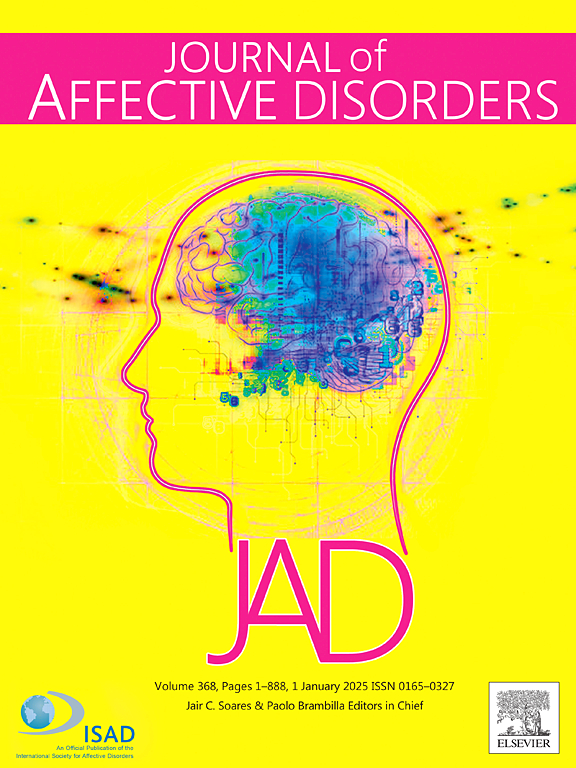Psychopathologies and quality of life in mental and functional disorders associated with persistent somatic symptoms
IF 4.9
2区 医学
Q1 CLINICAL NEUROLOGY
引用次数: 0
Abstract
Background
Persistent somatic symptoms (PSS) are a central diagnostic feature of several mental and functional disorders. However, only several studies simultaneously considered disorders from different systems. The purpose of this study was to explore the coexisting status of these diagnoses and to analyze the relationship between diagnoses and various psychopathologies, as well as quality of life (QOL).
Methods
We recruited participants from psychosomatic clinics and neighboring communities of a hospital. All individuals underwent semi-structured interviews covering functional and mental disorder diagnoses and completed self-administered scales measuring somatic distress, health anxiety, depression, anxiety, and QOL. The relationships between diagnoses, psychopathologies, and QOL were explored.
Results
This cross-sectional study included 502 individuals (mean age 44.54 years, 38.8 % males). Among the various diagnoses with PSS, the DSM-IV's undifferentiated somatoform disorder (USD) and DSM-5's somatic symptom disorder (SSD) were the most common. SSD had a high comorbidity rate with generalized anxiety disorder (GAD), major depressive disorder (MDD), and panic disorder. The diagnosis most strongly associated with the severity of somatic distress and health anxiety was the DSM-IV USD and DSM-5 SSD, respectively. MDD, GAD, panic disorder, and adjustment disorder had significant associations with various psychopathologies and QOL. Among the diagnoses with PSS, the DSM-IV USD had the highest correlation with QOL, primarily in the overall and physical domains.
Limitations
The clinical sample was collected from psychosomatic clinics and cannot represent other medical settings.
Conclusion
DSM-IV USD and DSM-5 SSD were the diagnoses with PSS most extensively and significantly associated with psychopathologies and QOL.
与持续躯体症状相关的精神和功能障碍的精神病理学和生活质量
背景:持续性躯体症状(PSS)是几种精神和功能障碍的核心诊断特征。然而,只有几项研究同时考虑了来自不同系统的疾病。本研究旨在探讨这些诊断的共存状况,并分析诊断与各种精神病理及生活质量(QOL)的关系。方法从某医院的心身门诊和邻近社区招募参与者。所有个体都接受了半结构化访谈,内容包括功能障碍和精神障碍诊断,并完成了自我管理的躯体痛苦、健康焦虑、抑郁、焦虑和生活质量量表。探讨诊断、精神病理与生活质量之间的关系。结果横断面研究纳入502例患者,平均年龄44.54岁,男性38.8%。在PSS的各种诊断中,DSM-IV的未分化躯体形式障碍(USD)和DSM-5的躯体症状障碍(SSD)最为常见。SSD与广泛性焦虑障碍(GAD)、重度抑郁障碍(MDD)和惊恐障碍的合并率较高。与躯体窘迫和健康焦虑的严重程度最相关的诊断分别是DSM-IV和DSM-5 SSD。MDD、GAD、惊恐障碍和适应障碍与各种精神病理和生活质量有显著相关性。在诊断为PSS的患者中,DSM-IV USD与生活质量的相关性最高,主要在整体和身体领域。临床样本是从心身诊所收集的,不能代表其他医疗机构。结论dsm - iv - USD和DSM-5 - SSD是诊断PSS最广泛且与精神病理和生活质量显著相关的诊断。
本文章由计算机程序翻译,如有差异,请以英文原文为准。
求助全文
约1分钟内获得全文
求助全文
来源期刊

Journal of affective disorders
医学-精神病学
CiteScore
10.90
自引率
6.10%
发文量
1319
审稿时长
9.3 weeks
期刊介绍:
The Journal of Affective Disorders publishes papers concerned with affective disorders in the widest sense: depression, mania, mood spectrum, emotions and personality, anxiety and stress. It is interdisciplinary and aims to bring together different approaches for a diverse readership. Top quality papers will be accepted dealing with any aspect of affective disorders, including neuroimaging, cognitive neurosciences, genetics, molecular biology, experimental and clinical neurosciences, pharmacology, neuroimmunoendocrinology, intervention and treatment trials.
 求助内容:
求助内容: 应助结果提醒方式:
应助结果提醒方式:


